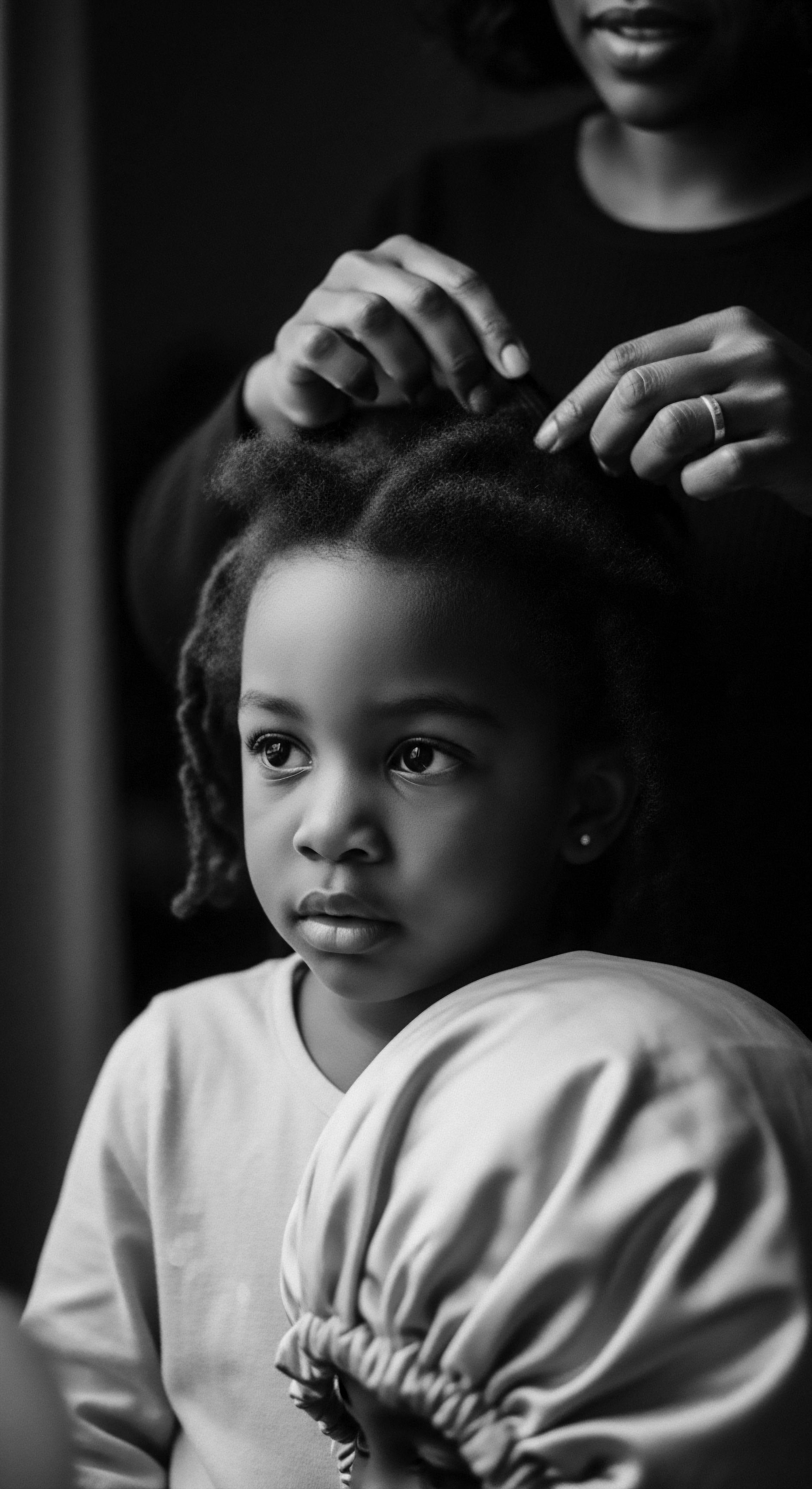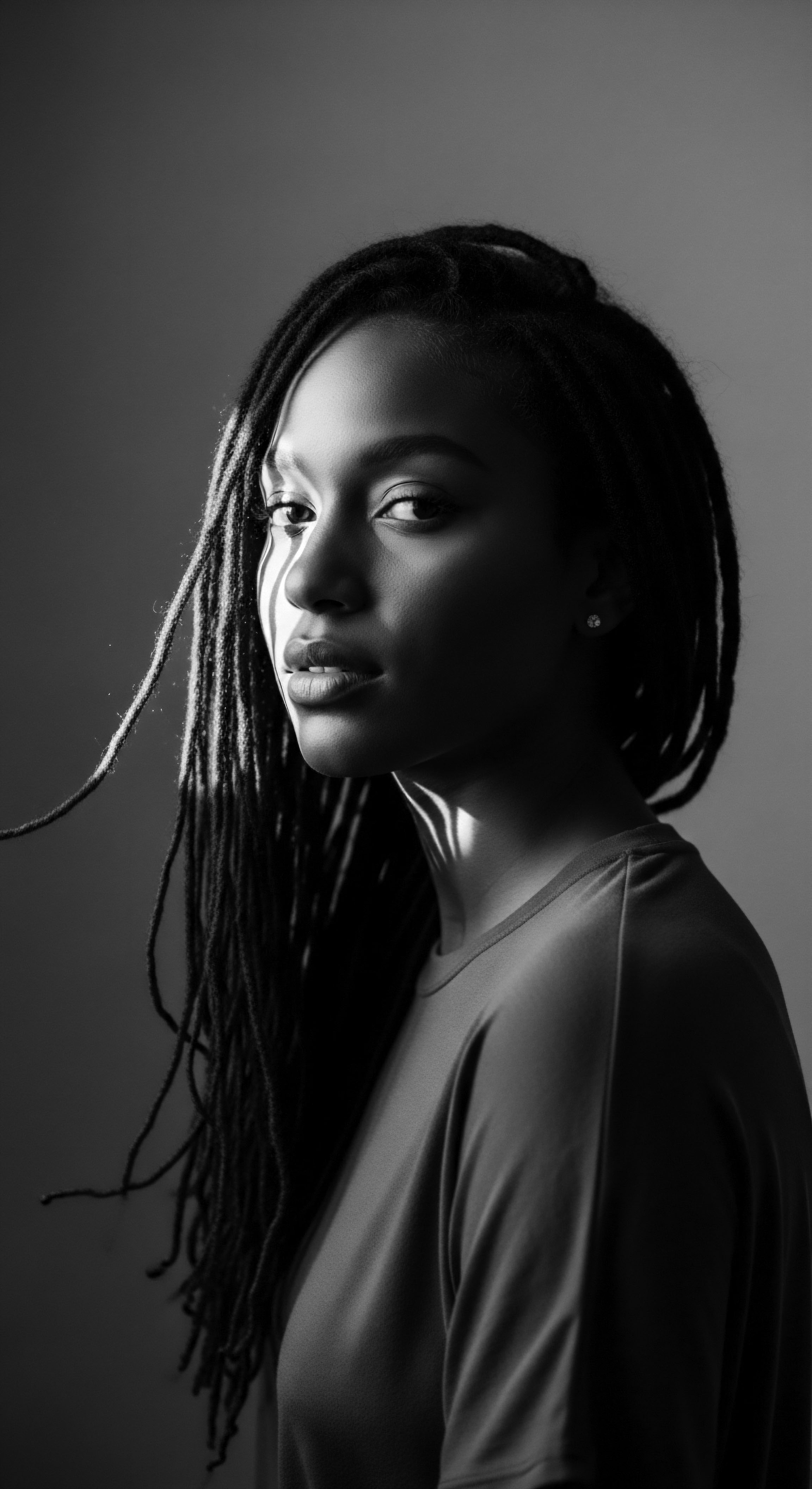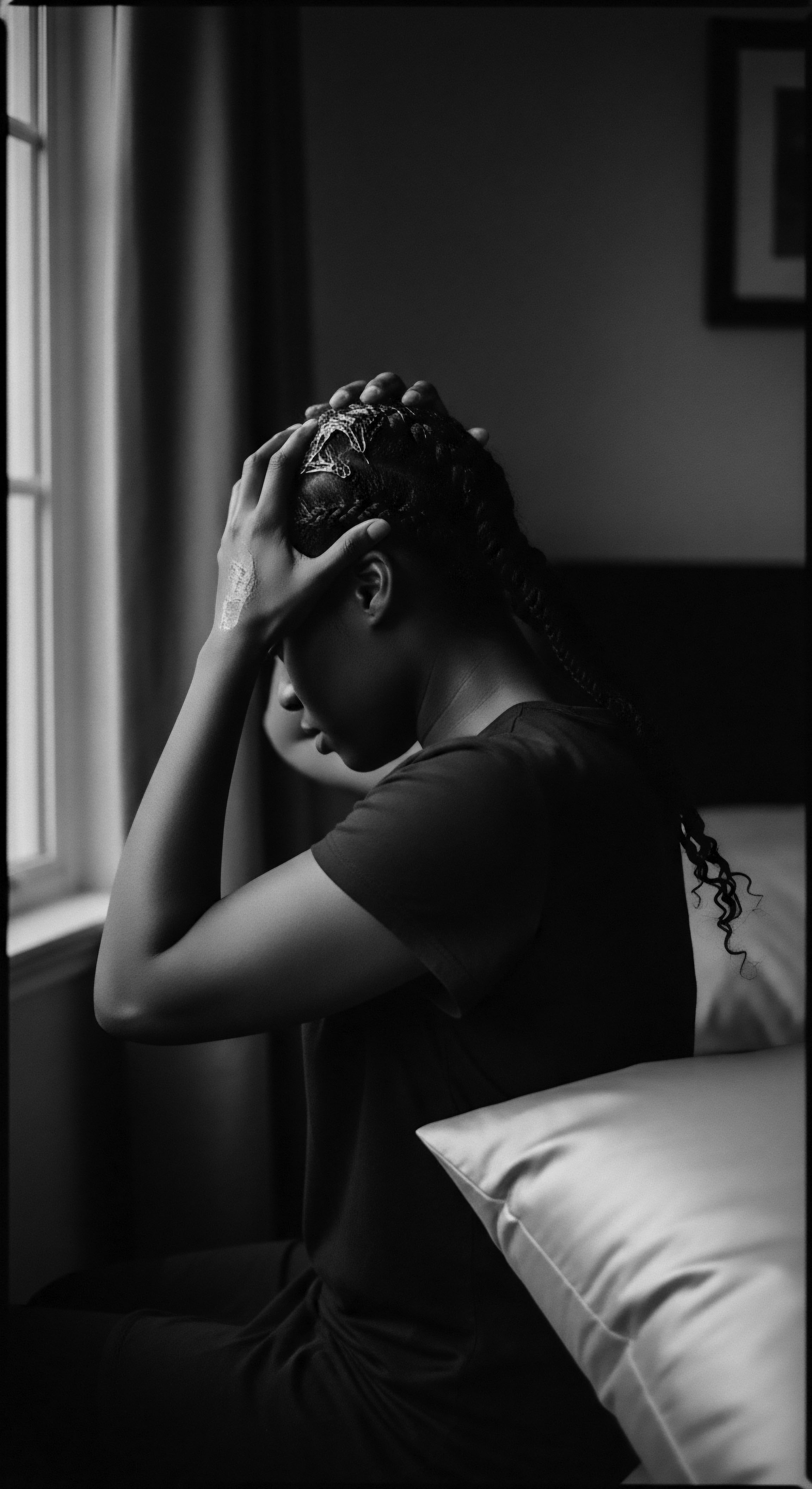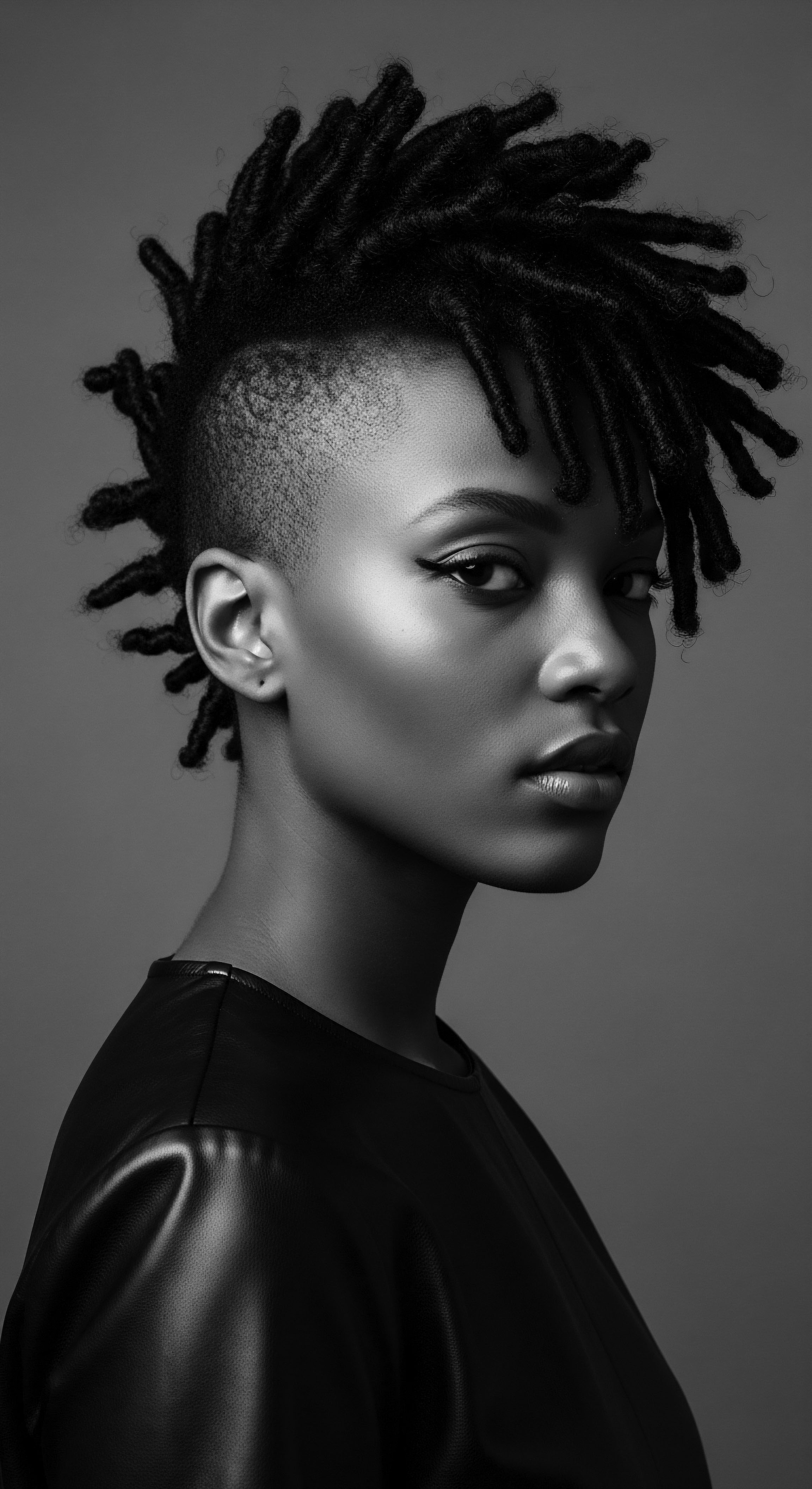
Fundamentals
Within the living library of Roothea, the term ‘Cultural Hair’ is not merely a descriptor of a physical attribute; it is a profound designation, an elucidation of the deep, ancestral connection between hair and identity, particularly for individuals of Black and mixed-race heritage. This fundamental explanation begins with the understanding that textured hair, in its myriad forms, has always been a repository of historical memory, a living testament to resilience, and a vibrant canvas for expression across generations. From the earliest communal gatherings to the present day, the strands that crown the head have carried meanings far beyond mere aesthetics.
The significance of Cultural Hair is rooted in the communal practices and spiritual understandings of ancient African societies. Before the profound disruptions of the transatlantic slave trade, hair served as a sophisticated visual language, a tangible expression of a person’s place within their community. Hairstyles conveyed age, marital status, social standing, tribal affiliation, and even spiritual beliefs. This early understanding underscores that hair was not a separate entity from the individual, but an integral part of their being, intimately tied to their soul and lineage.

Echoes from the Source ❉ Hair as an Ancient Map
In many pre-colonial African societies, the hair, particularly the crown of the head, was considered a point of entry for spiritual energy, a direct link to the divine and ancestral wisdom. This belief transformed hair care into a sacred ritual, often performed by close relatives, strengthening familial and communal bonds. The care of hair was a communal activity, a time for shared confidences and the passing down of generational knowledge.
Each twist, braid, or adornment held a specific connotation, a narrative etched into the very structure of the coiffure. For instance, the Himba tribe in Namibia crafted dreadlocked styles with red ochre paste, symbolizing their connection to the earth and their ancestors. In Yoruba culture, intricate hairstyles like “Irun Kiko” communicated femininity, marital status, and coming-of-age rites, with skilled braiders holding respected positions within society. The very act of styling hair was a profound statement, a declaration of one’s place in the world.
Cultural Hair, at its most fundamental, represents a profound connection to ancestral wisdom, where each strand carries the weight of history and the spirit of community.

The Earliest Expressions of Identity
The Wolof, Mende, Mandingo, and Yoruba societies, among others, used hair as a physical means to convey messages about marital status, age, religion, ethnic identity, wealth, and communal rank. The specific configuration of a hairstyle could even identify a person’s geographic origin. This communal language, spoken through hair, ensured that one’s identity was visible and celebrated within the collective.
- Adornments ❉ Natural materials like beads, shells, feathers, and even gold were incorporated into hairstyles, adding layers of meaning and beauty, often signifying wealth or religious devotion.
- Styling Tools ❉ Early African communities developed tools such as combs, pins, and razors, crafted from wood, bone, or ivory, not merely for grooming but as sacred objects buried with their owners, affirming the spiritual significance of hair care.
- Preparation ❉ Natural ingredients like clay, oils, and herbs were used to nourish and protect hair, a testament to an early understanding of holistic hair wellness rooted in the land.
This initial understanding of Cultural Hair sets the stage for a deeper exploration, revealing how these foundational meanings persisted and adapted through periods of immense challenge, forming the bedrock of textured hair heritage today. The hair, in its earliest context, was a living archive, documenting the story of a people.

Intermediate
Building upon its foundational meanings, the intermediate explanation of ‘Cultural Hair’ delves into how these ancestral practices and their inherent wisdom have been transmitted, adapted, and sustained across generations, particularly within Black and mixed-race communities. This section clarifies the enduring significance of Cultural Hair as a practical, living tradition, deeply intertwined with evolving hair care rituals and styling practices that affirm heritage and identity in the face of historical adversity. The focus shifts to the continuity of knowledge and the ingenious ways textured hair care traditions persevered through displacement and oppression.

The Tender Thread ❉ Generational Wisdom and Adaptation
The transatlantic slave trade presented an unparalleled assault on the identity and cultural practices of enslaved Africans. One of the first acts of dehumanization was the forced shaving of heads upon arrival in the Americas, a deliberate effort to strip individuals of their cultural identity and sever their connection to home, tribe, and family. Despite these brutal attempts at erasure, the spirit of Cultural Hair persisted, becoming a silent yet potent expression of identity in a foreign land. The wisdom of ancestral hair care, though challenged, found new ways to manifest.
Enslaved Africans, denied access to their traditional tools, oils, and the time for intricate styling, adapted with remarkable ingenuity. They used available materials like butter, bacon fat, or even hot knives to manage their hair, demonstrating an unyielding resolve to maintain some semblance of their heritage. Sundays, often the only day of rest, became communal hair care days, fostering a tradition of bonding and shared cultural practice that continues to resonate today. These sessions, often involving mothers and grandmothers, became vital conduits for transmitting knowledge and resilience.
Cultural Hair embodies the enduring spirit of adaptation, transforming acts of suppression into expressions of unwavering cultural preservation.

Continuity in Styling and Symbolism
Traditional African braiding techniques, such as cornrows (often called “canerows” in the Caribbean), were not only practical for managing hair in harsh conditions but also became covert communication tools. In Colombia, enslaved individuals braided intricate patterns into their hair to create maps and directions for escape routes or safe houses, a testament to hair’s role as a language of resistance. This ingenious use of hair demonstrates its deep meaning beyond mere appearance, serving as a lifeline to freedom.
Post-emancipation, as Black communities navigated new social landscapes, the relationship with Cultural Hair continued to evolve. While Eurocentric beauty standards often pressured individuals to straighten their hair for social and economic acceptance, the underlying heritage of textured hair remained a powerful, if sometimes hidden, force. The communal spirit of hair care, the knowledge of natural ingredients, and the symbolic value of various styles were carried forward, adapting to new environments and emerging as expressions of self-love and pride in later movements.
| Historical Period Ancient Africa |
| Traditional Practice (Pre-Colonial/Early Diaspora) Communal Braiding ❉ Social bonding, status, spiritual connection. |
| Adaptation/Continuity (During/Post-Slavery) Covert Communication ❉ Cornrows used as maps for escape routes. |
| Historical Period Transatlantic Slave Trade |
| Traditional Practice (Pre-Colonial/Early Diaspora) Natural Ingredients ❉ Shea butter, plant oils for nourishment. |
| Adaptation/Continuity (During/Post-Slavery) Resourceful Substitutes ❉ Animal fats, lye, household greases for hair management. |
| Historical Period Post-Emancipation |
| Traditional Practice (Pre-Colonial/Early Diaspora) Hair as Identity Marker ❉ Signifying tribal origin, marital status. |
| Adaptation/Continuity (During/Post-Slavery) Hidden Resistance ❉ Headwraps as dignity and cultural preservation, later reclaiming public space. |
| Historical Period The ongoing transformation of Cultural Hair practices illustrates a continuous journey of resilience and creative adaptation, affirming heritage through every historical turn. |

The Living Legacy of Care
The knowledge of how to care for textured hair, often considered “unmanageable” or “undesirable” under Eurocentric standards, was passed down through oral traditions and hands-on teaching within families. This intergenerational transfer of wisdom ensured that despite the loss of traditional tools and ingredients, the fundamental principles of care for coily, kinky, and curly hair persisted. The understanding that textured hair, due to its unique structure, requires specific attention to avoid breakage and maintain moisture became a deeply ingrained aspect of diasporic hair care.
From the careful detangling with wide-toothed combs (or improvised versions) to the practice of protective styling, these methods were not merely functional; they were acts of self-preservation and cultural affirmation. The emphasis on moisture retention, scalp health, and gentle manipulation, practices validated by modern science, finds its roots in these ancestral methods. The very act of caring for Cultural Hair became a ritual of self-love and remembrance, an active resistance against narratives that sought to diminish its beauty and inherent value.

Academic
At an advanced academic level, ‘Cultural Hair’ is understood as a dynamic biocultural construct, a profound statement, an elaborate explication, and a critical designation within the scholarly discourse surrounding textured hair, Black hair, and mixed-race hair heritage. It signifies the complex interplay of genetic predispositions, historical trajectories, psychosocial formations, and ongoing socio-political realities that collectively shape the meaning, experience, and expression of hair within these communities. This definition transcends superficial aesthetics, delving into the deep ontological and epistemological dimensions of hair as a site of identity, resistance, and ancestral memory.
The significance of Cultural Hair is not static; it is a living archive, continuously re-interpreted through the lens of lived experience and scholarly inquiry. It compels us to analyze how biological specificities of textured hair, such as its unique curl patterns and susceptibility to breakage, have been historically pathologized by Eurocentric beauty standards, leading to enduring disparities in perception and treatment. Conversely, it highlights how these very characteristics have been celebrated and leveraged within ancestral practices, forming the basis for resilient and culturally resonant hair care traditions.

Biocultural Significance ❉ The Helix as Heritage
The biological structure of textured hair, with its characteristic elliptical follicle shape and varied curl patterns, contributes to its unique mechanical properties and moisture retention challenges. Yet, this very biology has been culturally interpreted and adorned for millennia. The density and coiling of Afro-textured hair, for instance, offered natural insulation against intense sun in ancestral African environments.
This elemental biology, therefore, is not separate from its cultural meaning; rather, it provides the physical canvas upon which cultural narratives are inscribed. The explication of Cultural Hair at this level recognizes that the physical attributes are intrinsically linked to the social and spiritual roles hair plays.
From an anthropological perspective, Cultural Hair serves as a tangible link to ancestral practices and worldviews. In ancient African civilizations, hair was often considered the most elevated part of the body, closest to the divine, acting as a conduit for spiritual energy and communication with ancestors. This spiritual meaning imbued hair care with a ceremonial quality, transforming daily rituals into acts of reverence and connection. The meticulous processes of washing, oiling, braiding, and adorning hair were not merely hygienic or beautifying; they were sacred rites that fortified the individual’s spiritual well-being and communal belonging.
Cultural Hair is a profound testament to how biological traits are imbued with deep cultural and spiritual significance, forming an unbreakable bond with ancestral roots.

Sociopolitical Dimensions ❉ Hair as a Site of Struggle and Affirmation
The historical assault on Cultural Hair, particularly during the transatlantic slave trade and subsequent periods of colonialism and systemic racism, underscores its profound sociopolitical meaning. The forced shaving of heads of enslaved Africans was a deliberate act of dehumanization, designed to erase identity and sever ties to ancestral heritage. This act initiated a long legacy of discrimination against textured hair, where Eurocentric beauty standards imposed notions of “good” and “bad” hair, perpetuating colorism and texturism within Black communities. The systematic denigration of textured hair created a psychological burden, influencing self-perception and limiting opportunities.
Despite these pressures, Cultural Hair consistently emerged as a powerful tool of resistance and self-affirmation. The resilience of traditional styles, the ingenuity in adapting care practices, and the resurgence of natural hair movements throughout history exemplify this enduring spirit. For example, during the Civil Rights Movement in the United States, the Afro hairstyle became a potent political statement, a symbol of Black pride, unity, and a rejection of Eurocentric beauty norms. This shift marked a collective reclamation of identity, transforming hair from a perceived marker of inferiority into a visible declaration of self-acceptance and cultural heritage.
Consider the case of the “pencil test” in apartheid South Africa. This discriminatory practice, used to determine proximity to whiteness and access to privileges, involved inserting a pencil into a person’s hair to see if it would hold or fall out (Sizemore, 2016). This specific historical example powerfully illuminates how hair texture was weaponized as a key marker of racial classification and social status, demonstrating the direct and severe implications of external perceptions of Cultural Hair on individuals’ lives and societal structures.
The test served as a stark reminder of the deep-seated prejudice against natural Black hair and its role in enforcing racial hierarchies. This instance, though a singular event, provides a clear lens into the broader, insidious ways hair was used to oppress and control, making the subsequent movements for natural hair acceptance all the more significant as acts of defiance.

Scientific Validation of Ancestral Practices
Modern trichology and hair science increasingly offer explanations for the efficacy of long-standing ancestral hair care practices. The intricate coiling of textured hair, while beautiful, makes it more susceptible to breakage due to the numerous potential stress points along the hair shaft. This biological reality validates traditional practices that prioritized gentle handling, protective styling (like braiding and twisting), and consistent moisture application using natural oils and butters. The ancestral wisdom of “feeding” the hair with rich, emollient ingredients finds scientific backing in the need to prevent moisture loss from the hair’s cuticle, which is often more open in textured strands.
The understanding of Cultural Hair, therefore, bridges the divide between inherited wisdom and contemporary scientific inquiry. It acknowledges that ancestral communities, through observation and empirical knowledge passed down through generations, developed sophisticated care regimens that intuitively addressed the unique needs of textured hair. This perspective encourages a reciprocal relationship between tradition and science, where each informs and enriches the other, leading to a more holistic and culturally attuned approach to hair wellness.
The meaning of Cultural Hair extends to its role in contemporary social movements and legal frameworks, such as the CROWN Act in the United States, which prohibits discrimination based on hair texture or style. This legislative effort reflects an ongoing societal recognition of hair as a protected characteristic, intrinsically tied to racial identity and heritage. It underscores the enduring legacy of historical prejudice and the continued struggle for equitable treatment, affirming that the right to wear one’s hair naturally is a fundamental aspect of self-expression and cultural freedom.
- Ontological Significance ❉ Hair, in many African belief systems, is not merely a biological appendage but an extension of the self, a sacred antenna connecting individuals to the spiritual realm and ancestral wisdom.
- Epistemological Frameworks ❉ Traditional hair care rituals represent a body of embodied knowledge, passed through generations, that intuitively understood the unique needs of textured hair long before modern scientific classification.
- Psychosocial Impact ❉ The historical subjugation and subsequent reclamation of textured hair styles have had profound effects on self-esteem, collective identity, and social cohesion within Black and mixed-race communities.
- Economic and Cultural Industries ❉ The global textured hair care market, largely driven by the needs and preferences of Black and mixed-race consumers, represents a significant economic force rooted in cultural heritage and a desire for culturally appropriate products.

The Future of Heritage in Hair Science
The advanced study of Cultural Hair looks toward a future where ancestral knowledge is not just respected but actively integrated into scientific research and product development. This means moving beyond a Eurocentric framework of hair analysis and investing in deeper investigations into the unique biophysical properties of diverse textured hair types. It calls for collaborations between ethnobotanists, dermatologists, cultural anthropologists, and hair scientists to decode the efficacy of traditional ingredients and practices, ensuring that innovation truly serves the diverse needs of textured hair communities worldwide.
Furthermore, understanding Cultural Hair at this academic level involves a critical examination of how hair continues to shape perceptions of professionalism, beauty, and social acceptance. It advocates for policies and cultural shifts that dismantle discriminatory practices rooted in historical biases, fostering environments where all forms of textured hair are celebrated and respected. The long-term consequences of historical hair discrimination continue to influence societal norms, making the ongoing scholarly exploration of Cultural Hair essential for achieving true equity and cultural recognition. This comprehensive approach ensures that the rich heritage of textured hair remains a vibrant, acknowledged force in shaping the future of hair wellness and identity.

Reflection on the Heritage of Cultural Hair
As we draw our exploration of Cultural Hair to a close, we are reminded that its story is not confined to the annals of history; it breathes and flourishes in every coil, every braid, every lovingly tended strand. This deep meditation on Textured Hair Heritage, presented within Roothea’s living archive, reveals a legacy of profound strength, ingenuity, and unwavering spirit. The journey from elemental biology and ancient reverence, through the tender threads of communal care and adaptation, to its current role in voicing identity and shaping futures, is a testament to the enduring power of human connection to ancestry.
The Soul of a Strand ethos, guiding our understanding, recognizes that hair is a sacred extension of self, a tangible link to the wisdom of those who came before us. It is a crown of glory, not just in its outward presentation, but in the deep well of cultural memory it holds. When we care for our textured hair, we are not simply engaging in a routine; we are participating in a ritual, honoring a continuum of ancestral practices that have preserved beauty, dignity, and resistance through centuries. This act of care becomes a dialogue with the past, a celebration of the present, and a hopeful declaration for generations yet to arrive.
Cultural Hair, in its entirety, stands as a vibrant, living testament to the resilience of Black and mixed-race communities. It speaks of a heritage that could not be shorn away, a beauty that could not be denied, and a spirit that continues to inspire. Through its complex story, we discern a pathway to holistic wellness that is deeply rooted in tradition, validated by understanding, and illuminated by an unyielding appreciation for the unique ancestral narratives carried within each and every strand.

References
- Byrd, A. D. & Tharps, L. D. (2001). Hair Story ❉ Untangling the Roots of Black Hair in America. St. Martin’s Press.
- Johnson, T. & Bankhead, T. (2014). Hair It Is ❉ Examining the Experiences of Black Women with Natural Hair. Open Journal of Social Sciences, 2(10), 86-100.
- Omotos, A. (2018). The Symbolic Significance of Hair in Traditional African Culture. Journal of Pan African Studies, 11(4), 105-118.
- Sizemore, J. (2016). Kinky, curly hair ❉ a tool of resistance across the African diaspora. USC Dornsife News.
- Tharps, L. D. (2002). Hair Story ❉ Untangling the Roots of Black Hair in America. St. Martin’s Press.
- Gordon, M. (2018). The Cultural and Spiritual Significance of Hair in African Societies. Journal of African Studies.
- Mbodj, M. (2020). The Spiritual Significance of Hair in African Culture. Columbia University Press.
- Byrd, A. D. & Tharps, L. D. (2001). Hair Story ❉ Untangling the Roots of Black Hair in America. St. Martin’s Press.
- Thompson, A. (2009). Black Women and Identity ❉ A Historical Perspective on Hair and Self-Esteem. Routledge.
- Dove, A. & Powers, J. (2018). The Natural Hair Movement ❉ Identity, Culture, and Politics. University of California Press.
